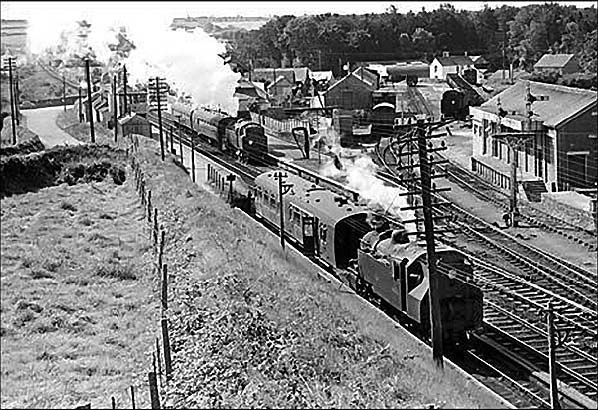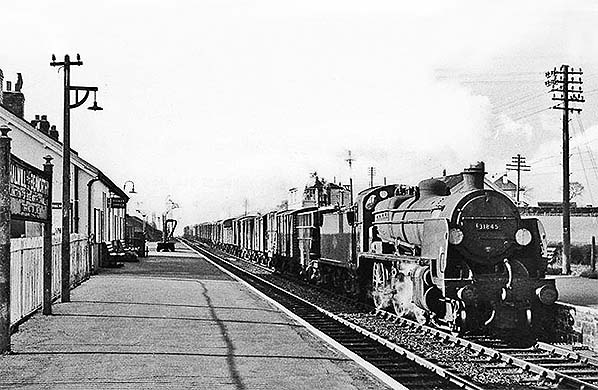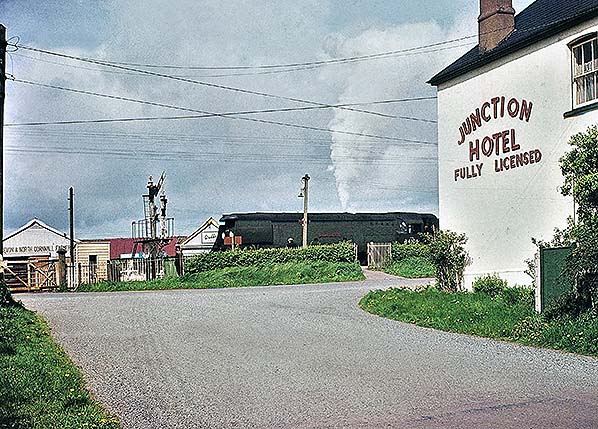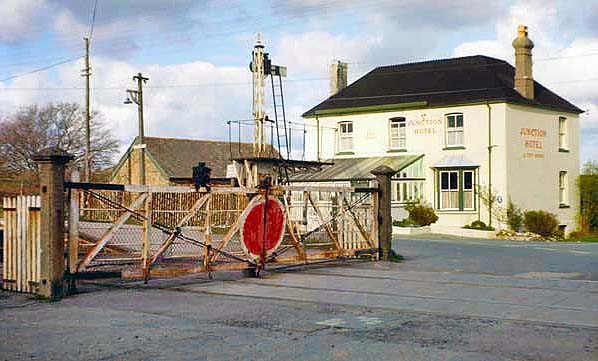
[Source:
Martin James]
Halwill Gallery 3: April 1963 - 1964 junction_old17.jpg) Again taken on Saturday 20 April 1963, here is 4MT tank No.80059 is preparing to depart for Bude with the portion split from the 09.56am ex-Okehampton - Padstow service. The Padstow train has, of course, already departed allowing No.80059, which would have been waiting outside the station, to enter the platform and couple to its train. The carriage partly visible on the left is Maunsell S6655S while the leading vehicle carries a destination board, this being to ensure passengers boarded the correct portion of the train. Its brake compartment appears to be well loaded. Maunsell S6655S, a brake composite, had, between September and November 1960, been part of set 168 paired with brake third (railway terminology, by this time third class had been rebranded second class) S2776S. For reasons unknown, in November 1960 S6659S replaced S6655S in set 168 and thereafter S6655S became a spare, or 'float' vehicle. The leading vehicle of the Bude train, which is unidentified, seen here would also have been from the float, which explains why it is coupled to S6655S at its brake end. Again taken on Saturday 20 April 1963, here is 4MT tank No.80059 is preparing to depart for Bude with the portion split from the 09.56am ex-Okehampton - Padstow service. The Padstow train has, of course, already departed allowing No.80059, which would have been waiting outside the station, to enter the platform and couple to its train. The carriage partly visible on the left is Maunsell S6655S while the leading vehicle carries a destination board, this being to ensure passengers boarded the correct portion of the train. Its brake compartment appears to be well loaded. Maunsell S6655S, a brake composite, had, between September and November 1960, been part of set 168 paired with brake third (railway terminology, by this time third class had been rebranded second class) S2776S. For reasons unknown, in November 1960 S6659S replaced S6655S in set 168 and thereafter S6655S became a spare, or 'float' vehicle. The leading vehicle of the Bude train, which is unidentified, seen here would also have been from the float, which explains why it is coupled to S6655S at its brake end.junction_old18.jpg) Also taken on Saturday 20 April 1963, this view from the Torrington platform shows No.80059 departing with the 10.33am (09.56 ex-Okehampton) to Bude. The photographer informs us the Torrington train, which he was to travel on, departed at 10.38. The locomotive was Ivatt 2-6-2T No.41298 and the train was the usual single coach. The open carriage door tells us, unsurprisingly, that it was a Bulleid vehicle. No.41298 was at this time shedded at Barnstaple Junction, this being the shed responsible for most workings between Torrington and Halwill. She went on to see the end of steam on the Southern Region, being withdrawn in July 1967 by which time, following a spell at Weymouth, she was at Nine Elms busying herself mainly on Waterloo - Clapham Junction empty stock workings. She survived into preservation and as of 2016 can be seen at the Isle of Wight Steam Railway. There is some irony in this as when BR was considering options for replacing the 02 tanks on the island, one option explored was to replace them with these 2MT tanks. In the end the surviving Ryde - Shanklin line was electrified and operated by ex-LT Standard Tube Stock units which commenced service in 1967.
Photo by Brian Johnson junction_old36.jpg) Ivatt 2-6-2T No.41294 has arrived at Halwill with her single Bulleid coach from Torrington in July 1963. The signal is 'off' for her to reverse out of the bay to the run-round loop in the left background. The run-round procedure is described in the next caption. Shortly after this photograph was taken, a local service would arrive from Padstow and the points on the left are set for it to enter Halwill's up platform. In the left background another locomotive can be seen. It is waiting to shunt some vans when the train from Padstow arrives. Photo by David Mitchell
junction_old37.jpg) Maunsell N class No.31843 has arrived at Halwill's up platform with her service from Padstow in July 1963. Her train comprises a 2-car Maunsell plus Bulleid passenger set, a parcels van of the CCT or PMV type and what appears to be a Conflat wagon. In the left background another locomotive has detached more vans or wagons from the train and these will either be forwarded south in a remarshalled train or sent to Bude or Barnstaple via Bideford.
Photo by David Mitchell junction_old38.jpg) Halwill saw much Mongoliping as the so-nicknamed 'Mongoliper' N class were very frequent visitors. Here, in July 1963, is No.31846 busying itself shunting some goods wagons as the shunter hangs on the cabside for a natter with the driver about all matters shunting. Coupled behind the locomotive is what appears to be an ex-LMS 20-ton brakevan although there is something not quite 'LMS' about the duckets. Duckets are the objects projecting from the sides of these vans which allowed guards to keep check of the train. This was an absolute necessity in the days of unfitted (i.e. not fitted with the continuous brake) goods trains. No.31846 was a senior resident of Exmouth Junction shed, being there from November 1950 until withdrawal in September 1964. Photographic evidence suggests that Exmouth Junction did little to keep its allocation looking reasonably presentable. No.31846 also shows signs of cylinder overheating.
Photo by David Mitchell junction_old39.jpg) On the same day in July 1963 as the pictures above here is BR Standard 2-6-4T No.80059 with one of the local Maunsell 'P set' trains. According to the headcode disc it has arrived from Bude and has terminated at Halwill. Built at Brighton in 1953, No.80059 began her service career on the London Midland Region before moving to the Southern Region in 1959. Her spell at Exmouth Junction shed was between July 1962 and October 1964. Earlier members of the Standard 4MT tanks had a problem with water tank vents obstructing drivers' view. The design was modified mid-production; No.80059 was the first of the redesign with tank vents located further forward and this helped alleviate the problem. The class also had fluted coupling rods and problems with these caused a redesign from No.80079 onwards. However, as far as is known the 4MT tanks up to No.80078 were never modified and thus retained their fluted rods. After moving from Exmouth Junction No.80059 had a spell on the Somerset & Dorset. Withdrawal, from Bath Green Park, came in November 1965 after a pathetically short life of just under thirteen years. She was not among the several class members to survive into preservation.
Photo by David Mitchell junction_old40.jpg) The storm clouds have come over in July 1963 as Maunsell N class 2-6-0 No.31847 arrives at Halwill from Okehampton with a Padstow train. The rear of the train is visible to the left of the crossing keeper's hut, enabling train length to be determined as five or six vehicles but whether or not this train was part of the ACE is not recorded. At the level crossing a pantechnicon-type vehicle waits patiently. 'Pantechnicon' is a somewhat archaic name for what we now call a furniture van and had its origins back in the days of horse-drawn vehicles. The Southern style shunt signal adjacent to the hut permitted 'wrong line' shunting movements and this was essential at Halwill due to the need to split or join trains within the station platforms.
Photo by David Mitchell  An elevated view looking due south across Halwill station, believed taken in April 1964. By this time Halwill came under BR Western Region so, if the date is correct, steam would soon be ousted by diesel multiple units. In the Torrington bay, foreground, an Ivatt 2MT tank waits to depart bunker-first with the usual single Bulleid coach which is a brake composite. Presumably first class accommodation was advertised on the Torrington trains but one wonders just how many passengers opted for this relative luxury on these lightly used services. In those days first class was generally double the second class fare. At the main part of Halwill station a BR Standard 4MT tank departs with a train for Bude. A third locomotive is present, in the goods yard. It appears to be another 4MT tank and not involved with shunting wagons of which very few are present. It is probably involved in the joining and splitting of passenger trains, this being a regular occurrence at Halwill. This view has a number of similarities to one of those taken one year earlier on 20 April 1963. Both tanks on passenger tanks being the same type and both running bunker-first; the first coach of the 2-car Bude train coupled with its brake-end innermost; the open door near the brake-end of the Bulleid coach. However, we know this view was taken at a different time as the Ivatt tank has its headcode disc in a different (and incorrect) position relative to the 1963 view. Presumably the Ivatt had not been fitted with irons to suit the Southern disc system which remained valid, insofar as Halwill was concerned, into Western Region days.
Photo from John Mann collection  April 1964, and a lengthy mixed goods train from Padstow clatters south through Halwill. The train comprises a mix of open wagons and closed vans, plus a 'Presflo' behind the locomotive. There is also at least one loaded Conflat, third wagon behind the locomotive. It is likely that the train did not depart Padstow at this length but picked up further wagons at Wadebridge. An Exmouth Junction resident at this time, No.31845 was withdrawn five months after this photograph was taken.
Photo by Ben Brooksbank  In May 1964 a Bulleid West Country class No.34106 'Lydford' prepares to depart from Halwill towards Okehampton heading the ‘Atlantic Coast Express’. In the left background a shop of the West Devon & North Cornwall Farmers’ co-operative can be seen. Although the name is now defunct, it is thought that the business is now part of Countrywide Farmers. The Junction Hotel is still in business today, as the Junction Inn. Inside a number of railway photographs and other related items are displayed. Viewed here from Dreybury Lane, the camera would today be looking towards the housing development of Halwill Junction, the settlement which grew up around the railway and which is a different location to Halwill itself. As for 'Lydford', she had been an Exmouth Junction resident since early 1958 and was withdrawn four months after this photograph was taken when a mere fourteen years old. She had been scrapped. by the end of 1964 by the end of 1964.
Click here for Halwill Gallery 4: August 1964 - c1964
|

junction_old35.jpg) In July 1963, Maunsell N class No.31843 comes off the North Cornwall line and crosses over into Halwill's up platform. Just visible in the Torrington bay is Ivatt 2-6-2T No.41294, with the usual single coach. The procedure for Torrington trains arriving at Halwill was as follows. Once passengers, if any, had alighted and before waiting passengers, if any, boarded and any parcels etc. unloaded, the locomotive would push its train to a run-round loop situated some way beyond the station and just before the Torrington and Bude lines parted company. Here the locomotive would run round, recouple and push its train back into the bay platform. The loop was not operated from the signal box but its points were unlocked from it. There was also a connection between the Torrington and Bude lines, the only one between these routes at Halwill, and normally used only by goods trains and for empty stock movements. Of the locomotives seen here, No.31843 survived until September 1964 while No.41294 soldiered on until September 1966. She was shedded at Barnstaple Junction from June 1957 until April 1963, this shed being responsible for many of the steam workings beyond Torrington to Halwill.
In July 1963, Maunsell N class No.31843 comes off the North Cornwall line and crosses over into Halwill's up platform. Just visible in the Torrington bay is Ivatt 2-6-2T No.41294, with the usual single coach. The procedure for Torrington trains arriving at Halwill was as follows. Once passengers, if any, had alighted and before waiting passengers, if any, boarded and any parcels etc. unloaded, the locomotive would push its train to a run-round loop situated some way beyond the station and just before the Torrington and Bude lines parted company. Here the locomotive would run round, recouple and push its train back into the bay platform. The loop was not operated from the signal box but its points were unlocked from it. There was also a connection between the Torrington and Bude lines, the only one between these routes at Halwill, and normally used only by goods trains and for empty stock movements. Of the locomotives seen here, No.31843 survived until September 1964 while No.41294 soldiered on until September 1966. She was shedded at Barnstaple Junction from June 1957 until April 1963, this shed being responsible for many of the steam workings beyond Torrington to Halwill. This pleasant view towards the Junction Hotel over Halwill level crossing is let down only by the somewhat scruffy condition of the gates. There were four gates arranged as two pairs, with the keeper’s hut located just off the picture to the left. No confirming details have come to light, but the likely situation was the gates being interconnected in pairs so as one gate was swung a linkage swung another simultaneously. The lattice post signal is the Halwill up starter. It is rather close to the gates, a not untypical LSWR feature, which may explain why the gates were apparently opened to the railway some time before a train was ready to depart. Train drivers were and are highly skilled people and not in the habit of over-running signals (known today as SPAD - Signals Passed At Danger) but it did and does happen from time to time and demolished level crossing gates were not unknown. Regulations required that signals could not be set to 'off' when gates were closed to the railway and this was achieved by interlocking. At Halwill, the crossing keeper’s hut would have been linked to the signal box for this reason. Generally the small pedestrian gates either side of a level crossing would also be interlocked so they could not be opened when a train was due. Although this view is colour, it is difficult to date as they are no clues such as road vehicles visible. However, difficult to see here but visible on a larger version are television aerials on the left chimneystack of the Junction Hotel. BBC television did not become available in this area until 1956, from North Hessary Tor transmitter, with UHF arriving in 1964 from the then also new Redruth transmitter. The aerials on the hotel appear to include a UHF example, if so the earliest date for this photograph would be 1964. The hotel still trades today and is now known as the Junction Inn. Little information on the building's history appears to be available in the public domain but we can assume its existence was due to the arrival of the railway at Halwill.
This pleasant view towards the Junction Hotel over Halwill level crossing is let down only by the somewhat scruffy condition of the gates. There were four gates arranged as two pairs, with the keeper’s hut located just off the picture to the left. No confirming details have come to light, but the likely situation was the gates being interconnected in pairs so as one gate was swung a linkage swung another simultaneously. The lattice post signal is the Halwill up starter. It is rather close to the gates, a not untypical LSWR feature, which may explain why the gates were apparently opened to the railway some time before a train was ready to depart. Train drivers were and are highly skilled people and not in the habit of over-running signals (known today as SPAD - Signals Passed At Danger) but it did and does happen from time to time and demolished level crossing gates were not unknown. Regulations required that signals could not be set to 'off' when gates were closed to the railway and this was achieved by interlocking. At Halwill, the crossing keeper’s hut would have been linked to the signal box for this reason. Generally the small pedestrian gates either side of a level crossing would also be interlocked so they could not be opened when a train was due. Although this view is colour, it is difficult to date as they are no clues such as road vehicles visible. However, difficult to see here but visible on a larger version are television aerials on the left chimneystack of the Junction Hotel. BBC television did not become available in this area until 1956, from North Hessary Tor transmitter, with UHF arriving in 1964 from the then also new Redruth transmitter. The aerials on the hotel appear to include a UHF example, if so the earliest date for this photograph would be 1964. The hotel still trades today and is now known as the Junction Inn. Little information on the building's history appears to be available in the public domain but we can assume its existence was due to the arrival of the railway at Halwill.
 Home Page
Home Page